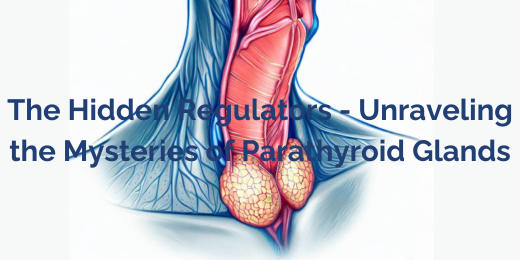Parathyroid gland function
The parathyroid glands, often overlooked but of immense importance, serve as hidden regulators within the body. These small, pea-sized glands are nestled within the thyroid gland and play a crucial role in maintaining calcium balance and bone health. Their function revolves around the secretion of parathyroid hormone (PTH), which helps regulate calcium levels in the blood. By closely monitoring the calcium concentration, the parathyroid glands ensure proper bone mineralization and nerve and muscle function.
When the levels fluctuate, the glands swiftly adjust PTH secretion to restore balance. Understanding the intricacies of parathyroid gland function allows us to appreciate their vital role in maintaining the body’s equilibrium and underscores the significance of these often-unseen regulators.
Anatomy of Parathyroid Glands
The parathyroid glands, four small endocrine glands located behind the thyroid gland, are crucial components of the body’s intricate regulatory system. Despite their small size, these glands play a vital role in maintaining calcium balance and supporting overall health. Each parathyroid gland consists of two distinct cell types: chief cells, responsible for producing parathyroid hormone (PTH), and oxyphil cells, which function remains less understood.
The function of parathyroid glands is crucial in maintaining calcium homeostasis and supporting overall health. Through the secretion of parathyroid hormone (PTH), these glands play a vital role in regulating calcium levels in the blood. PTH ensures proper bone formation and maintenance, as well as facilitates nerve and muscle function. Understanding the anatomy of the parathyroid glands provides valuable insight into their essential role in maintaining balance within the body. By actively monitoring and adjusting calcium levels, the parathyroid glands contribute significantly to overall health and well-being. Appreciating the significance of parathyroid gland function emphasizes the importance of their role in supporting various physiological processes necessary for optimal functioning.
Function of Parathyroid Glands
The parathyroid glands play a crucial role in regulating calcium levels and maintaining bone health. These small endocrine glands, usually four in number, are located behind the thyroid gland in the neck. Their main function is to produce and release parathyroid hormone (PTH), which helps control the levels of calcium and phosphorus in the body. PTH acts on the bones, kidneys, and intestines to ensure that calcium is mobilized from the bones, absorbed from the intestines, and excreted or conserved by the kidneys, depending on the body’s needs.
This hormone is essential for maintaining the balance of calcium in the blood, which is vital for proper nerve function, muscle contraction, and the formation and maintenance of healthy bones. Thus, the parathyroid gland function is essential for overall calcium regulation and bone health.
Parathyroid Hormone (PTH)
The parathyroid glands secrete an essential hormone called parathyroid hormone (PTH), which plays a critical role in maintaining the balance of calcium within the body. When blood calcium levels drop, the parathyroid glands detect this and release PTH. PTH acts on various target organs to increase blood calcium levels. Firstly, it stimulates the release of calcium from the bones, where it is stored, by activating specialized cells called osteoclasts. This process is known as bone resorption. Secondly, PTH enhances the absorption of calcium from the intestines by promoting the activation of vitamin D, which facilitates calcium uptake.
Lastly, PTH reduces calcium loss through the kidneys by promoting reabsorption of calcium in the renal tubules. By increasing calcium levels in the blood, PTH ensures that there is sufficient calcium available for proper nerve and muscle function and supports bone health. Therefore, the secretion and function of parathyroid hormone are crucial in maintaining calcium balance throughout the body.
Disorders and Imbalances
The parathyroid glands can be affected by various disorders, two of the most common being hyperparathyroidism and hypoparathyroidism. Hyperparathyroidism occurs when the parathyroid glands produce an excessive amount of parathyroid hormone (PTH). This leads to increased levels of calcium in the blood, which can cause symptoms like fatigue, kidney stones, bone pain, and digestive issues. On the other hand, hypoparathyroidism is characterized by insufficient production of PTH.
This condition results in low levels of calcium in the blood, leading to symptoms such as muscle cramps, tingling sensations, and spasms. Both disorders can significantly impact calcium balance and disrupt normal bodily functions. Proper diagnosis, treatment, and management of these parathyroid gland disorders are essential for maintaining optimal health.
Diagnosis and Treatment
Various diagnostic procedures are utilized to assess parathyroid gland function and diagnose related disorders. Blood tests are conducted to measure calcium, phosphorus, and parathyroid hormone (PTH) levels. Elevated calcium and PTH levels can indicate hyperparathyroidism, while low calcium and abnormal PTH levels may suggest hypoparathyroidism. Imaging techniques such as Ultrasound, Sestamibi Scan, and CT/MRI scans assist in locating any irregularities in the parathyroid glands.
Additionally, fine needle aspiration biopsy may be performed to analyze parathyroid gland cells. Treatment options for parathyroid gland disorders depend on the specific condition. Surgical removal of affected parathyroid glands, known as parathyroidectomy, is commonly recommended for hyperparathyroidism. Calcium and vitamin D supplementation are often prescribed for hypoparathyroidism. Close monitoring of calcium and PTH levels is essential for effective management.



